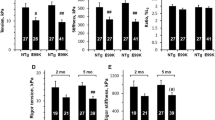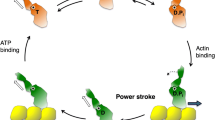Abstract
Familial hypertrophic cardiomyopathy, a disease caused by mutations in cardiac contractile proteins, is characterized by left and/or right ventricular hypertrophy, myocyte disarray, fibrosis, and cardiac arrhythmias that may lead to premature sudden death. Five distinct point mutations within α-tropomyosin are associated with the development of familial hypertrophic cardiomyopathy. Two of these mutations are found within a troponin T binding site, located at amino acids 175 and 180. In this study, we analyze a transgenic mouse model for one of the mutations that occur at codon 180: a substitution of a glutamic acid for a glycine. These mice develop severe cardiac hypertrophy, substantial interstitial fibrosis, and have an increased heart weight/body weight ratio. Results show that calcium-handling proteins associated with the sarcoplasmic reticulum exhibit decreased expression. These alterations in gene expression, coupled with the structurally-altered tropomyosin, may contribute to the demonstrated decreased physiological performance exhibited by these transgenic mice. A DNA hybridization microarray analysis of the transgenic vs. control ventricular RNAs shows that 50 transcripts are differentially expressed by more than 100% during the onset of the hypertrophic process, many of which are associated with the extracellular matrix. This study demonstrates that mutations within tropomyosin can be severely disruptive of sarcomeric function, triggering a hypertrophic response coupled with a cascade of alterations in gene expression.
Similar content being viewed by others
References
Thierfelder L, Watkins H, MacRae C, Lamas R, McKenna W, Vosberg H, Seidman J, Seidman C: α-Tropomyosin and cardiac troponin T mutations cause familial hypertrophic cardiomyopathy: A disease of the sarcomere. Cell 77: 701-712, 1994
Nakajima-Taniguchi C, Matsue H, Kishimoto T, Yamachi-Takihara K: Novel missense mutation in α-tropomyosin gene found in Japanese patients with hypertrophic cardiomyopathy. J Mol Cell Cardiol 27: 2053-2058, 1995
Karibe A, Tobacman L, Strand J, Butters C, Back N, Bachinski L, Arai A, Ortiz A, Roberts R, Homsher E, Fananapazir L: Hypertrophic cardiomyopathy caused by a novel að-tropomyosin mutation (V95A) is associated with mild cardiac phenotype, abnormal calcium binding to troponin, abnormal myosin cycling, and poor prognosis. Circulation 103: 65-71, 2001
Muthuchamy M, Pieples K, Rethinasamy P, Hoit B, Grupp I, Boivin G, Wolska B, Evans C, Solaro JR, Wieczorek DF: Mouse model of a familial hypertrophic cardiomyopathy mutation in α-tropomyosin manifests cardiac dysfunction. Circ Res 85: 47-56, 1999
Prabhakar R, Boivin G, Grupp I, Hoit B, Arteaga G, Solaro RJ, Wieczorek DF: A familial hypertrophic cardiomyopathy α-tropomyosin mutation causes severe cardiac hypertrophy and death in mice. J Mol Cell Cardiol 33: 1815-1828, 2001
Evans C, Pena J, Phillips R, Muthuchamy M, Wieczorek D, Solaro R, Wolska B: Altered hemodynamics in transgenic mice harboring a mutant tropomyosin (Asp175Asn) linked to hypertrophic cardiomyopathy. Am J Physiol Circ Physiol 279: H2414-H2423, 2000
Muthuchamy M, Grupp I, Grupp G, O'Toole B, Kier A, Boivin G, Neumann J, Wieczorek DF: Molecular and physiological effects of overexpressing striated muscle β-tropomyosin in the adult murine heart. J Biol Chem 270: 30593-30603, 1995
Sussman M, Lim H, Gude N, Taigen T, Olson E, Robbins J, Colbert M, Gualberto A, Wieczorek D, Molkentin J: Prevention of cardiac hypertrophy in mice by calcineurin inhibition Science 281: 1690-1693, 1998
Aronow B, Toyokawa T, Canning A, Haghighi K, Delling U, Kranias E, Molkentin J, Dorn G: Divergent transcriptional responses to independent genetic causes of cardiac hypertrophy. Physiol Genomics 6: 19-28, 2001
Maas A, Leinwand L: Animal models of hypertrophic cardiomyopathy. Curr Opin Cardiol 15: 189-196, 2000
Farza H, Watkins H: Animal models of familial hypertrophic cardiomyopathy. Mol Med Today 5: 544-545, 1999
Michele D, Metzger J: Physiological consequences of tropomyosin mutations associated with cardiac and skeletal myopathies. J Mol Med 78: 543-553, 2000
Chou P, Fasman G: Conformational parameters for amino acids in helical, β-sheet, and random coil regions calculated from proteins. Biochem 13: 211-222, 1974
Golitsina N, An Y, Greenfield N, Thierfelder L, Seidman J, Seidman C, Lehrer S, Hitchcock-DeGregori S: Effects of two familial hypertrophic cardiomyopathy-causing mutatios on α-tropomyosin structure and function. Biochem 36: 4637-4642, 1997
Bing W, Knott A, Redwood C, Esposito G, Purcell I, Watkins H, Marston S: Effect of hypertrophic cardiomyopathy mutations in human cardiac muscle alpha-tropomyosin (asp175asn and glu180gly) on the regulatory properties of human cardiac troponin determined by in vitro motility assay. J Mol Cell Cardiol 32: 1489-1498, 2000
Molkentin J, Lu J, Antos C, Markham B, Richardson J, Robbins J, Grant S, Olson E, a calcineurin-dependent transcriptional pathway for cardiac hypertrophy. Cell 93: 215-228, 1998
Sato Y, Ferguson D, Sako H, Dorn G, Kadambi V, Yatani A, Hoit B, Walsh R, Kranias E: Cardiac-specific overexpression of mouse cardiac calsequestrin is associated with depressed cardiovascular function and hypertrophy in transgenic mice. J Biol Chem 273: 28470-28477, 1998
D'Angelo D, Sakata Y, Lorenz J, Boivin G, Walsh R, Liggett S, Dorn G: Transgenic Gαq overexpression induces cardiac contractile failure in mice. Proc Natl Acad Sci USA 94: 8121-8126, 1997
Bueno L, DeWindt L, Tymitz K, Witt S, Kimball T, Klevitsky R, Hewett T, Jones S, Lefer D, Peng C, Kitsis R, Molkentin J: The MEK1ERK1/2 signaling pathway promotes compensated cardiac hypertrophy in transgenic mice. The EMBO J 19: 6341-6350, 2000
Author information
Authors and Affiliations
Rights and permissions
About this article
Cite this article
Prabhakar, R., Petrashevskaya, N., Schwartz, A. et al. A mouse model of familial hypertrophic cardiomyopathy caused by a α-tropomyosin mutation. Mol Cell Biochem 251, 33–42 (2003). https://doi.org/10.1023/A:1025409227350
Issue Date:
DOI: https://doi.org/10.1023/A:1025409227350




